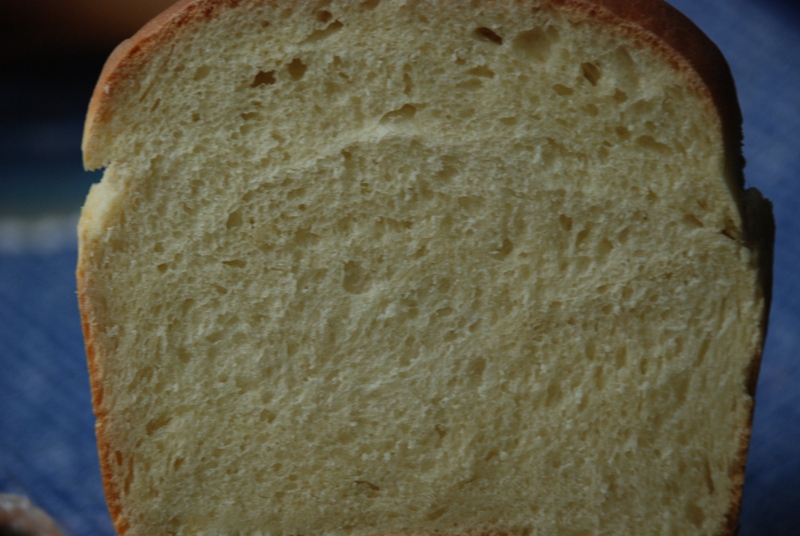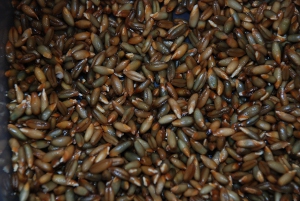

I have been making the same loaf of bread since Sunday and it's not even sourdough. It is my first Pain de Mie, using the formula that Syd posted here. Usually when people tell me what a lot of work it must be to make bread, I say it doesn't take much time or effort - mostly you let the dough do the work. That does not hold for this bread. Syd's instructions say to work this dough until it either has a gossamer windowpane, or your arms cramp up. Since my arms never cramped up even though they were (and still are) extremely tired, I worked the dough with a few short breaks for an hour and 10 minutes. No gym today. In theory I could have used my Kitchen Aid stand mixer. In practice it would probably have been the last time I used it.
Since I have never made/bought/eaten this type of bread before I have no idea if it came out the way it should.

I will say it's the most flavorful white bread I've ever tasted.

A few baking notes:
The third day of the formula, or baking day, calls for "whole egg 140g." I thought maybe ostrich egg? I clicked through to the site that Syd referenced hoping for some clarification. Unfortunately I can't read Chinese characters so no help there. I ended up putting in 3 medium eggs which came to 156g. Comparing my crumb to Syd's his seems to be a lot whiter, so that may have been incorrect.
Update: Syd's instructions call for heating the milk for the first mix (the water roux) but not for the next two. I scalded for each of these because that's just what I do, but didn't know if it was necessary or not.
During mixing, the dough stayed fragile until around 40 minutes. At around 50 minutes it seemed to be getting stronger and silkier. I went back to the Chinese site to see if they had any pictures of what it should look like. They did. I wasn't there yet so I kept going until an hour and ten minutes, at which point it was strong enough to twirl around like a pizza.
Syd didn't mention steam, and I wasn't sure if that is called for in this type of bread. Google translate was no help. I finally decided to do steam for the first 15 minutes. I baked one slightly smaller loaf in a pyrex bread pan (5 x 9 x 2.5 inches) and the second in my short Pullman (4 x 9 x 4). Since I was reasonably sure that I wouldn't repeat the disaster of a few days ago where my attempt at a second Borodinsky went very wrong, I decided to cover the Pullman. It didn't overflow. It did reach the top. My first success in covered Pullman baking. I baked the Pyrex loaf at 356F (180C) for 35 minutes and the Pullman loaf for 40. Could probably have baked each longer, but I didn't want to push it. These aren't supposed to be crusty loaves after all, given that Pain de Mie seems to mean Crumb Bread. (Sounds better in French.)
Update: I divided dough as 956g of dough into the Pullman and 820g into the Pyrex.
So I have now baked an Asian Pain de Mie or a facsimile thereof. Wonder how a French Pain de Mie would differ. Just about everything I'm doing here is new to me. I have certainly never hand-worked dough for over an hour before - maximum maybe 25 minutes. Any suggestions for improvements are decidedly welcome.
Oh, and incidentally this is either the 4th or 5th of Syd's formulas that I have tried, or around half of the number posted. More please! They are most interesting and excellent.
Bonus Rye Malt
In my efforts to make a second Borodinsky more authentic than the first, I took Janet's suggestion to make Rye Malt. While I did find a few detailed suggestions on the web for how to do this, I still found it confusing, so I hope these documented steps will be helpful.
Step 1: Find rye berries. --- I found them at a food co-op in Cambridge MA which seemed to have bulk berries of many different varieties.
Step 2: Soak for 5 hours --- I only soaked 60g worth because I didn't know what I was doing

Step 3: Drain, rinse, and then keep moist while the berries sprout. In the picture below they are just starting to sprout around 16 hours after soaking is complete. I placed a wet paper towel on top of the berries, and had to remoisten it a few times.

Step 4: Put on a baking tray to dry out in the oven. The picture at the top of the post where the berries are fully sprouted was taken 23 hours after the one above.
Step 5: Dry out at very low heat for around 2 hours. I kept the oven between 100F and 200F by acting as the oven thermostat.
Step 6: Grind them up. I used a coffee grinder.

It's certainly not red. I have no idea if it's Borodinsky appropriate. But I will say that my Borodinsky didn't fail because of the malt.